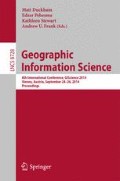Abstract
In this paper we introduce a new logical calculus of the Region Connection Calculus (RCC) family, RCC*-9. Based on nine topological relations, RCC*-9 is an extension of RCC-8 and models topological relations between multi-type geometric features: therefore, it is a calculus that goes beyond the modeling of regions as in RCC-8, being able to deal with lower dimensional features embedded in a given space, such as linear features embedded in the plane. Secondly, the paper presents a modified version of the Calculus-Based Method (CBM), a calculus for representing topological relations between spatial features. This modified version, called CBM*, is useful for defining a reasoning system, which was difficult to define for the original CBM. The two new calculi RCC*-9 and CBM* are introduced together because we can show that, even if with different formalisms, they can model the same topological configurations between spatial features and the same reasoning strategies can be applied to them.
Access this chapter
Tax calculation will be finalised at checkout
Purchases are for personal use only
Preview
Unable to display preview. Download preview PDF.
References
Aref, W.G., Samet, H.: Optimization Strategies for Spatial Query Processing. In: 17th International Conference on Very Large Databases, Barcelona, Spain, pp. 81–90 (1991)
Bennett, B.: Logical Representations for Automated Reasoning about Spatial Relationships. Ph.D. Thesis, School of Computer Studies, University of Leeds (1997)
Clementini, E., Di Felice, P.: A Comparison of Methods for Representing Topological Relationships. Information Sciences 3, 149–178 (1995)
Clementini, E., Di Felice, P.: A Model for Representing Topological Relationships Between Complex Geometric Features in Spatial Databases. Information Sciences 90, 121–136 (1996)
Clementini, E., Di Felice, P., van Oosterom, P.: A Small Set of Formal Topological Relationships Suitable for End-User Interaction. In: Abel, D.J., Ooi, B.-C. (eds.) SSD 1993. LNCS, vol. 692, pp. 277–295. Springer, Heidelberg (1993)
Clementini, E., Skiadopoulos, S., Billen, R., Tarquini, F.: A reasoning system of ternary projective relations. IEEE Transactions on Knowledge and Data Engineering 22, 161–178 (2010)
Codd, E.F.: A relational model for large shared data banks. Communications of the ACM 13, 377–387 (1970)
Cohn, A.G., Bennett, B., Gooday, J., Gotts, N.: Qualitative Spatial Representation and Reasoning with the Region Connection Calculus. GeoInformatica 1, 275–316 (1997)
Cohn, A.G., Renz, J.: Qualitative Spatial Representation and Reasoning. In: Harmelen, F.V., Lifschitz, V., Porter, B. (eds.) Handbook of Knowledge Representation, vol. 1, pp. 551–596. Elsevier (2007)
Cohn, A.G., Varzi, A.C.: Mereotopological connection. Journal of Philosophical Logic 32, 357–390 (2003)
Cui, Z., Cohn, A.G., Randell, D.A.: Qualitative and Topological Relationships in Spatial Databases. In: Abel, D.J., Ooi, B.-C. (eds.) SSD 1993. LNCS, vol. 692, pp. 296–315. Springer, Heidelberg (1993)
Egenhofer, M.J.: Deriving the composition of binary topological relations. Journal of Visual Languages and Computing 5, 133–149 (1994)
Egenhofer, M.J., Clementini, E., Di Felice, P.: Topological relations between regions with holes. International Journal of Geographical Information Systems 8, 129–142 (1994)
Egenhofer, M.J., Franzosa, R.D.: Point-Set Topological Spatial Relations. International Journal of Geographical Information Systems 5, 161–174 (1991)
Egenhofer, M.J., Herring, J.R.: Categorizing Binary Topological Relationships Between Regions, Lines, and Points in Geographic Databases. Department of Surveying Engineering, University of Maine, Orono, ME Technical Report (1990)
Gabrielli, N.: Investigation of the Tradeoff between Expressiveness and Complexity in Description Logics with Spatial Operators. Ph.D. Thesis: University of Verona (2009)
Galton, A.: Modes of overlap. Journal of Visual Languages and Computing 9, 61–79 (1998)
Galton, A.: Multidimensional Mereotopology. In: Dubois, D., Welty, C., Williams, M.-A. (eds.) Proceedings of the Ninth International Conference on Principles of Knowledge Representation and Reasoning (KR 2004), Whistler, BC, Canada, June 2-5, pp. 45–54. American Association for Artificial Intelligence (2004)
Galton, A.P.: Taking dimension seriously in qualitative spatial reasoning. In: Proceedings of the Twelfth European Conference on Artificial Intelligence (ECAI 1996), Budapest, Hungary, August 11-16 (1996)
Gerevini, A., Renz, J.: Combining topological and size information for spatial reasoning. Artificial Intelligence 137, 1–42 (2002)
Gotts, N.M.: Formalizing Commonsense Topology: The INCH Calculus. pp. In: Proceedings of the Fourth International Symposium on Artificial Intelligence and Mathematics (1996)
Isli, A., Cabedo, L.M., Barkowsky, T., Moratz, R.: A Topological Calculus for Cartographic Entities. In: Habel, C., Brauer, W., Freksa, C., Wender, K.F. (eds.) Spatial Cognition 2000. LNCS (LNAI), vol. 1849, pp. 225–238. Springer, Heidelberg (2000)
OGC Open Geospatial Consortium Inc. OpenGIS Simple Features Implementation Specification for SQL. vol. OGC 99–049 (1999)
Wölfl, S., Mossakowski, T., Schröder, L.: Qualitative constraint calculi: Heterogeneous verification of composition tables. In: 20th International FLAIRS Conference (FLAIRS 2007), pp. 665–670 (2007)
Author information
Authors and Affiliations
Editor information
Editors and Affiliations
Rights and permissions
Copyright information
© 2014 Springer International Publishing Switzerland
About this paper
Cite this paper
Clementini, E., Cohn, A.G. (2014). RCC*-9 and CBM*. In: Duckham, M., Pebesma, E., Stewart, K., Frank, A.U. (eds) Geographic Information Science. GIScience 2014. Lecture Notes in Computer Science, vol 8728. Springer, Cham. https://doi.org/10.1007/978-3-319-11593-1_23
Download citation
DOI: https://doi.org/10.1007/978-3-319-11593-1_23
Publisher Name: Springer, Cham
Print ISBN: 978-3-319-11592-4
Online ISBN: 978-3-319-11593-1
eBook Packages: Computer ScienceComputer Science (R0)

